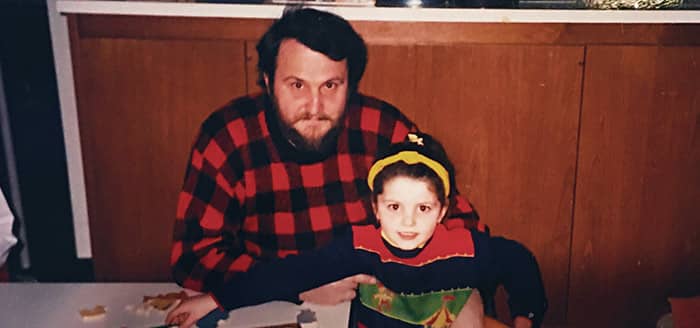Australian Editor Calls Keytruda “Last Stop” for Her Father’s Mesothelioma

“My dad is an incredible man,” Sandi Sieger recently told the Mesothelioma + Asbestos Awareness Center. “He’s the smartest guy I know, a bit like a walking encyclopedia.”
An avid reader, gardener, and music player, Sandi’s dad (Robert) did everything he could for Sandi and her siblings. “Dad gave me the best he could,” Sandi recalled, “but more than that, he gave me his time, and imparted so many life lessons, just by being himself. I’ve always felt, my whole life, that I’ve had someone on my side, someone who’s got my back, and that’s been dad.”
Given the strength and support Robert provided for his family, it was understandably a stressful time when he was hospitalized this past February with symptoms of an unknown disease. Doctors tried to find out what was causing these problems, performing exploratory surgery and taking a biopsy. Then, in March, they got an answer.
“Dad’s diagnosis came as a bit of a shock,” said Sandi, who was 31 at the time. That diagnosis was mesothelioma, a rare and deadly form of cancer caused by asbestos exposure.
The Effects of Mesothelioma
The physical effects and symptoms of mesothelioma can be severe, especially in later stages of the disease. “It has definitely affected him physically,” Sandi told MAA Center. “He struggles to walk due to shortness of breath. He went from being a big teddy bear of a guy to losing a lot of weight. He lost his appetite.”
Nonetheless, Sandi says her father is a fighter. “My dad is quite physically and mentally strong, and while I know he battles some days – emotionally and mentally – he doesn’t really show it. He’s usually quite frank about where he’s at, and for one of the most self-proclaimed pessimistic people in the world, his willingness to fight, his desire to live, and his strength has been pretty astounding.”
As he received a battery of treatments in an attempt to put the cancer into remission, Robert has kept his spirits as high as possible. “He’s not really given up hope,” Sandi explained, “even though he’s had major setbacks, and even through six months of hell, where he was deteriorating rapidly with negative result after negative result.”
Still, mesothelioma takes a heavy toll on the body, and it can wear even the strongest fighters down. “Some days the pain was so bad, you could tell he wasn’t himself. That was hard to witness,” Sandi admitted. “Thankfully, he is doing a little better now.”
Keytruda Offers New Hope
 Even while Robert was undergoing chemotherapy and radiation treatments, she was looking into other options for treating mesothelioma. That’s when she stumbled on Keytruda (pembrolizumab), a form of immunotherapy that is currently being studied to determine its effectiveness for treating mesothelioma patients.
Even while Robert was undergoing chemotherapy and radiation treatments, she was looking into other options for treating mesothelioma. That’s when she stumbled on Keytruda (pembrolizumab), a form of immunotherapy that is currently being studied to determine its effectiveness for treating mesothelioma patients.
“I’d read about the great results it was showing in other mesothelioma patients,” Sandi explained, “but at the end of the day, it still only seems to work for one in five people. I think I just clung onto the hope that Dad would be the one in five. Keytruda was also the last stop; he had tried everything else, and this was literally the last hope.”
The family looked into Keytruda more, and given the poor results with more traditional treatments, they decided to go for it. Robert went on Keytruda, and the results turned out to be what Sandi had been hoping for.
“Our experience with Keytruda has been, overall, positive,” Sandi reported. “Thankfully dad hasn’t had any side effects that can sometimes force people to stop immunotherapy treatment. It’s worth being aware of the side effects and any associated costs.”
In fact, the results were so good that recently the oncologist who was treating Robert said he had never seen anything like it before. “It’s exciting to think what that means for this disease,” Sandi said, “as they continue to research and learn about it, but for me, it’s exciting to have my dad back.”
Keytruda Costs, Availability, and the Cancer Moonshot
The results of Keytruda are incredible for Robert, but it has not come cheaply. Because the drug is still only being tested as part of clinical trials, it is not readily available to everyone. Living in Melbourne, Australia, Sandi says that the drug’s cost varies greatly based simply on which form of cancer it is being used to treat.
“My dad isn’t part of a trial,” Sandi told MAA Center. “He is paying his way through an expensive treatment. In Australia, if you suffer from melanoma, Keytruda will cost you $36 a treatment. My dad pays almost $7,000 a treatment for Keytruda for mesothelioma.”
For that reason, Sandi wants Keytruda to be put on the Pharmaceutical Benefits Scheme, a program run by the Australian Government’s Department of Health that provides certain medicines free of charge to retirees and others in the community.
In the United States, many people run into similar issues related to affordable health care, and the cost of Keytruda can vary from person to person, based on where they live, what health insurance coverage they have, and other factors including which forms of cancer have been approved for treatment by the FDA. In the U.S., Keytruda is currently approved to treat melanoma, non-small cell lung cancer (NSCLC), and metastatic head and neck squamous cell carcinoma (HNSCC).
Immunotherapy drugs like Keytruda are one of the biggest focuses of the Cancer Moonshot Initiative currently headed by Vice President Joe Biden. Sandi believes this effort is a step in the right direction.
“Quite simply, I’m not sure my Dad would still be alive without Keytruda,” she said. “So it’s absolutely everything, but we need more of it – more money thrown at it, more time invested, more researchers, more, more, more.”
Stopping Mesothelioma at Its Source
 Of course, even better than needing more (and more affordable) Keytruda to treat mesothelioma would be stopping this terrible cancer before it even has a chance to develop by stopping, or at least severely limiting, exposure to asbestos. The good news is that mesothelioma is an entirely preventable disease; the bad news is that we still don’t seem to have figured out a way to get asbestos banned and removed from all the places where it currently exists.
Of course, even better than needing more (and more affordable) Keytruda to treat mesothelioma would be stopping this terrible cancer before it even has a chance to develop by stopping, or at least severely limiting, exposure to asbestos. The good news is that mesothelioma is an entirely preventable disease; the bad news is that we still don’t seem to have figured out a way to get asbestos banned and removed from all the places where it currently exists.
Like so many men who have been diagnosed with mesothelioma, Robert Sieger was exposed to asbestos at work. “My dad was a wall and floor tiler,” she told MAA Center. “In the 1960s and 70s, he dealt with a lot of AC sheeting – cutting, scoring, sawing – and the product contained asbestos. He remembers working on sites where the air was thick with dust. He remembers shaking off his dust-laden clothes at the end of a workday. My dad worked with products that claimed to be ‘a miracle fibre of the 20th Century.’ When it came to light that, in fact, the products were poisonous and carcinogenic, he stopped using them, as did other workers in his industry.”
Unfortunately, by the time Sandi’s dad knew to stop using these asbestos products, the damage was done, due to the long latency period of the disease. “It can take 30-40 years for those exposed to asbestos fibers to show signs of illness,” Sandi explained, “and for many the signs appear when it is already too late. I remember, as a child, when news stories would be on the TV about asbestos, dad would say, ‘I hope I don’t get that one day.’ He knew his exposure to the product had been quite significant.”
In Australia, as many as one in three homes contain asbestos, and the statistics in the U.S. may not be much better. Most buildings built before the 1980s contain asbestos in some form or another, and there are daily news stories about asbestos being found in schools, college dorms, public buildings, and offices throughout the country.
For her part, Sandi is working hard to do what she can to inform the public. As the editor-in-chief of Onya Magazine – an Australian lifestyle publication – Sandi is writing stories to make sure her audience is aware of the dangers that asbestos holds. She’s also writing stories for other news organizations as well, and reaching out to government officials to press them to do more.
“In Australia, the peak for this horrific disease is yet to hit – but it is fast coming, and it is going to be an epidemic,” Sandi said. “I hope I can do something about that, for all the other families that will go through what we currently are.”